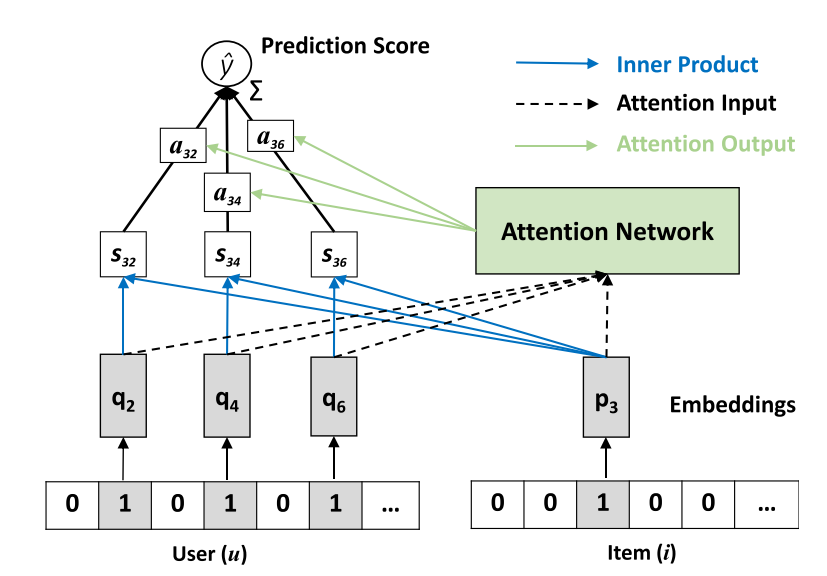NAIS¶
Introduction¶
Title: NAIS: Neural Attentive Item Similarity Model for Recommendation
Authors: Xiangnan He, Zhankui He, Jingkuan Song, Zhenguang Liu, Yu-Gang Jiang, and Tat-Seng Chua
Abstract: Item-to-item collaborative filtering (aka.item-based CF) has been long used for building recommender systems in industrial settings, owing to its interpretability and efficiency in real-time personalization. It builds a user’s profile as her historically interacted items, recommending new items that are similar to the user’s profile. As such, the key to an item-based CF method is in the estimation of item similarities. Early approaches use statistical measures such as cosine similarity and Pearson coefficient to estimate item similarities, which are less accurate since they lack tailored optimization for the recommendation task. In recent years, several works attempt to learn item similarities from data, by expressing the similarity as an underlying model and estimating model parameters by optimizing a recommendation-aware objective function. While extensive efforts have been made to use shallow linear models for learning item similarities, there has been relatively less work exploring nonlinear neural network models for item-based CF. In this work, we propose a neural network model named Neural Attentive Item Similaritymodel(NAIS) for item-based CF. The key to our design of NAIS is an attention network, which is capable of distinguishing which historical items in a user profile are more important for a prediction. Compared to the state-of-the-art item-based CF method FactoredItem SimilarityModel(FISM), our NAIS has stronger representation power with only a few additional parameters brought by the attention network. Extensive experiments on two public benchmarks demonstrate the effectiveness of NAIS. This work is the first attempt that designs neural network models for item-based CF, opening up new research possibilities for future developments of neural recommender systems.

Running with RecBole¶
Model Hyper-Parameters:
embedding_size (int): The embedding size of users and items. Defaults to64.weight_size (int): The vector that projects the hidden layer into an output attention weight. Defaults to64.algorithm (str): The attention method. Defaults to'prod'. Range in['prod', 'concat'].split_to (int): This is a parameter used to reduce the GPU memory usage during the evaluation. The larger the value, the less the memory usage and the slower the evaluation speed. Defaults to0.alpha (float): It is a hyper-parameter controlling the normalization effect of the number of user history interactions when calculating the similarity. Defaults to0.0.beta (float): It is the smoothing exponent controlling the denominator of softmax, it will be set in the range of[0, 1]. Obviously, when beta is set to1,it rcovers the softmax function; whenbetais smaller than1,the value of denominator will be suppressed, as a result, the attention weights will not be overly punished for active users. Defaults to0.5.reg_weights (list): The L2 regularization weights. Defaults to[1e-7, 1e-7, 1e-5].pretrain_path (str or None): The path of pre-trained model for initialization. Defaults toNone.
A Running Example:
Write the following code to a python file, such as run.py
from recbole.quick_start import run_recbole
run_recbole(model='NAIS', dataset='ml-100k')
And then:
python run.py
Tuning Hyper Parameters¶
If you want to use HyperTuning to tune hyper parameters of this model, you can copy the following settings and name it as hyper.test.
learning_rate choice [0.01,0.005,0.001,0.0005,0.0001]
weight_size choice [64]
reg_weights choice ['[1e-7, 1e-7, 1e-5]','[0,0,0]']
alpha choice [0]
beta choice [0.5]
Note that we just provide these hyper parameter ranges for reference only, and we can not guarantee that they are the optimal range of this model.
Then, with the source code of RecBole (you can download it from GitHub), you can run the run_hyper.py to tuning:
python run_hyper.py --model=[model_name] --dataset=[dataset_name] --config_files=[config_files_path] --params_file=hyper.test
For more details about Parameter Tuning, refer to Parameter Tuning.
If you want to change parameters, dataset or evaluation settings, take a look at